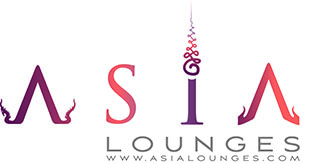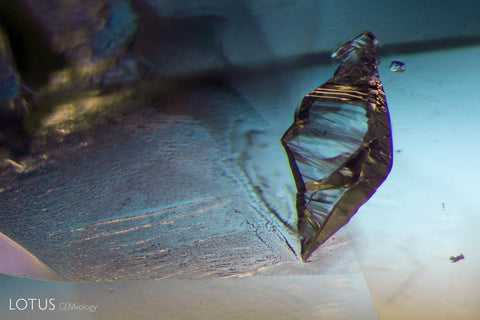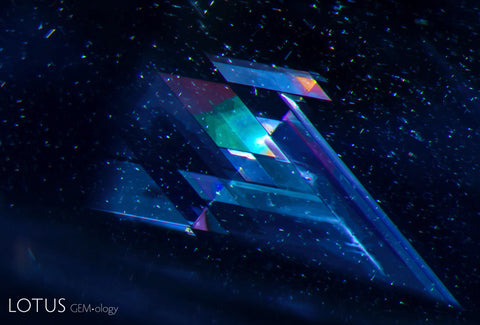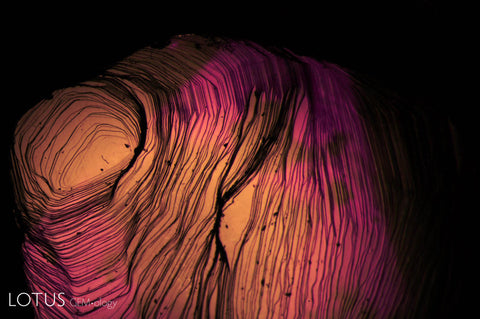Hey Loungers,
By now we have all heard of the legendary Lotus Gemology team. We all know via papers and interviews, the ruby & sapphire colossus, Richard W. Hughes, and his equally talented daughter, E. Billie Hughes. Yet little is known about the missing link in that trinity.
Wimon Manorotkul is not only a talented gemmologist in her own right, and a skilled photographer to boot, But she is arguably the person that brought the other two members of her family to the world of gems.
You read that right, she is the one who enrolled Richard for his first gemmological class.
Want to know more about this pioneering gemmo lady? Then read on. Wimon, the floor is yours.

We introduce you to Wimon Manorotkul here in a gem market in Myanmar - Photo Credits: Lotus Gemology
AsiaLounges: First of all, thank you, K. Wimon, for being with us today in the Lounges. It’s always a pleasure to meet up and today we have the privilege of hosting one of your rare media appearances. Shall we start with learning a bit more about you? Who are you?
Wimon Manorotkul: Thanks for having me on. I am a gemologist, a gem photographer, a photomicrographer, a proud mother of Billie Hughes, and also the President of Lotus Gemology.
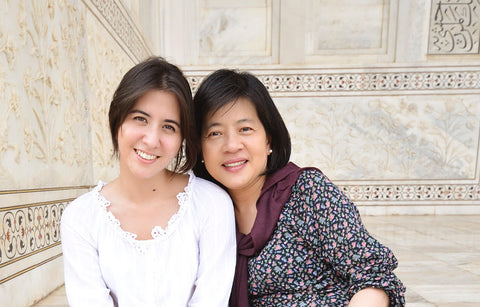
Here is Wimon and her daughter Billie by the Taj Mahal - Photo Credits: Lotus Gemology
AsiaLounges: We like to ask to our guests how they got into the gem trade. What was your reason to get in? Was it originally a family business or was it a passion that appeared later in life?
Wimon Manorotkul: I entered this business by luck. My background was not gem related at all. I was freshly graduated from business school and looking for any job so that I didn’t have to work in my family’s business. My job search ended up with me landing as registrar at Asian Institute of Gemological Sciences (AIGS), where I met my husband, Richard Hughes. Just into my first week, I found that students anticipated that, since I was working there, I should be able to answer their gemological questions, but I couldn’t. Since I didn’t want to look like a fool, I decided to begin reading the class text books so I could share knowledge with students. Of course, working with gems was more interesting than signing up students, so that’s how my interest in gems began.
AsiaLounges: What took precedence in your career, photography or gemology? Or did they happen at the same time? Is one of these parts of your professional persona dearest to you than the other?
Wimon Manorotkul: It started with teaching gemology. Richard and I were teaching how to identify natural and synthetics/treatments classes. We realized that it would be helpful if students could see more photos of inclusions other than those on Dr. Gübelin and John Koivula’s PhotoAtlas of Inclusions In Gems. So, we started taking inclusion photos to use in the class. My earlier work on inclusions was for teaching purposes only. They were snapshots – nothing more – even though they fascinated me. Then I looked at John Koivula’s work and thought about how I might make inclusion photos like his. One tip from him enlightened me. He said you have to look at each photo like a work of art. And that inspired me. Inclusion photos were no longer just a snapshot to document what I was seeing, but something where I could collaboreate with nature to create art.
Which part do l like better, gemology or photomicrography? I don’t know. One leads to the other. There is so much to learn and always something new in gemology; similarly, there is always something new to find inside a stone. They are related subjects. Gem photography is different, though. I get satisfaction doing good gem photos, but I like shooting inclusions more than gem photos. Inclusions are fascinating and more challenging.
AsiaLounges: The gem world, at least in business-to-business, is massively male dominated. In your opinion, why is that? What makes a world that revolves around enhancing female beauty be driven by old dudes?
Wimon Manorotkul: I think old habits die hard. Men have always been expected to be the bread winners of the family. It used to be men only that traveled the world. In the past, it was not easy for women to do that and in some part of the world it’s still not easy. But women are seeping into every industry around the world. Nowadays, if you go into jewelry shops or gem dealers’ offices, you will find women greatly involved in the business, as sales staff, shop owners, gem dealers and/or gemologists.
AsiaLounges: I understand that while living in the USA, you worked for Pala International. Tell us more about your work there, from teaching, shooting and, I assume a gem testing standpoint?
Wimon Manorotkul: Pala International was a great company to work with. They deal with cut stones, mineral specimens and also operate a jewelry store.
Living and working in Bangkok I knew nothing about mineral specimens. It was from working there that I learned to appreciate them. It still astonishes me how some of those delicate specimens are dug out of the ground and transported across the world in pristine condition. Pala’s owner, Bill Larson is an interesting person. He is not just a gem and mineral dealer, but a real connoisseur and also a book collector. While Bill has one of the best gem and mineral book collections in the world, his mineral collections will make your jaw drop. While working there I saw mesmerizing opal specimens, and I got to hold one of the biggest Burma ruby specimen and had my photo taken with it. Bill regularly hired Jeff Scovill, one of the most famous gem and specimen photographer to shoot some of his important pieces and I had opportunities to watch Jeff worked and learned from him. That’s how my gem photography started. Thank you both Bill and Jeff. It was such a great pleasure working there.

What do you think of this stunning pair of Burmese Imperial jade Cabochon photographed by Wimon Manorotkul - Photo Credits: Lotus Gemology
AsiaLounges: Now, back to your lab, Lotus Gemology, what does the average day of a gemmologist at Lotus looks like? Can you tell us, without revealing the secrets of the gods, what the path of a gem or piece of jewellery is that comes to your lab? How it is tested and why it is tested?
Wimon Manorotkul: Like most gem labs, we evaluate and make our decisions based on our acquired data, as well as that published in the gemological literature. Most of the time, just by first glance we can make an educated guess about what type of stones they are. But that guess requires verification via testing data. We will check visible, infrared, Raman and photoluminescence spectra and/or refractive indexes to make sure our sight ID was right. Other tests like UV fluorescence sometimes help to determine if the stone was treated.
Following the collection of basic data, we move to the microscope, which is the most important instrument for our work, since much of it involves origin and treatment determination. There are other tests, too, but not all need to be tested the same way. For example, some heated rubies or sapphires may need to be tested to find out if they are beryllium diffusion treated. Others may require trace element analysis. Yellow and orange sapphires or padparadschas will be tested for color stability; all stones with fractures will be checked if they are fissure filled.
Much of our time is spent observing stones under magnification. Unusual, interesting or beautiful inclusions will get special attention and will be sent to photomicrography and then sometimes to the micro Raman to identify the inclusions.
AsiaLounges: Bridging a bit the last two questions, have you ever considered teaching photography and/or gemmology again? Is it something that the Lotus team as a whole is, or would be considering in the future?
Wimon Manorotkul: We are passionate about gems and photography, so we won’t rule that out. However, for the time being we have so many projects in the pipeline. New projects will have to wait.

Stunning Burmese ruby in matrix held photographed by Wimon Manorotkul - Photo Credits: Lotus Gemology
AsiaLounges: Little bit of reality, we are, hopefully, reaching the end of the COVID19 crisis and are likely about to enter in a full economic crisis that is reminiscent of 1929. How do you see the future of our industry? How do you see this crisis impacting our industry and what will, in your opinion be the role that the labs will play in tomorrow's market?
Wimon Manorotkul: I don’t think I am in a position to predict people’s spending abilities. Just six months ago, who could have predicted where we would be today? But our business deals with non-essential products so you can expect that people will tend to save their cash, rather than spending it on non-essentials. There are a lot of people all over the world losing jobs, companies are going bankrupt, malls are closed, developers selling off properties to raise cash. I think we can expect to see a downturn for the next year or two.
All governments are pumping cash into the system to boost the economy, but people will still watch their spending. I think we will be under deflation for a while, but what’s next is hard to say. There could be a lot of money floating in the market, but what will people do with it? From this experience, will people be more careful and save more, or are they going to start spending or investing because interest rate is so low? I hope it’s the latter. But our biggest problem right now is that people cannot travel. I can only hope we can open our borders so that planes start flying again soon.
As for the future, I think on-line shopping for commercial grades are getting more traction, but I don’t expect people to change their buying habits for higher end stones. More gem connoisseurs are looking for information before buying. Before spending a lot of money, they want to know what they are getting. At Lotus Gemology, we believe in education. We believe that when people know more about gems, they will have more confidence in buying and investing in them. When they have confidence, when they can trust their jewellers, they will buy more. Our role as a gem lab is to provide people with good, unbiased information. Dealers also should provide full disclosure about their products. If our common goal is to encourage people to buy and collect gems, we should work together to educate clients. That’s why Lotus Gemology publishes books and articles and that’s why we share our knowledge with everyone. Humans have adored gems for thousands of years and that will not change. We just have to give buyers the comfort and confidence in buying something so unique that will stay with their family for generations.
AsiaLounges: Further to the last question is the now infamous topic of ethical stickers that people want to put everywhere. What do you think about it? Is ethics an important topic for you, personally and collectively at Lotus Gemology? What impact do you think it really has in the trade?
Wimon Manorotkul: I think most people have good intentions and try through their actions to have a positive impact on the world. However, you must also recognize that there are some who, despite their public statements, may have hidden agendas. This is a huge topic and needs a lot of input from people from all sides.
Before you put up a sign saying you buy only from responsible miners, have you asked miners what they actually think a responsible miner is? Are we creating a market where only big companies that can produce effective propaganda can claim that they are ethical? What about small miners that have no ads on social media. Are they ethical? Regarding fair trade, have you asked dealers, miners, or cutters in Tanzania, Mozambique, Myanmar, Sri Lanka or Thailand what they think is fair? Have you asked how much each sector of this industry should make to be fair to them? It is hard to judge.
Those I have asked typically say they should get what they ask for because they put a lot in either in terms of labour work or money or time so it justify how much they are making on selling a stone.
You want all kids in poor mining towns to go to school, but have you asked them where their school is located? I used to be one of those people who thought these parents were irresponsible. How could they make their children help in the mine carrying dirt for them? That was when I saw the mining situation only in photos or in the news. After visiting these mines myself, after speaking to them personally, I realized I that, while I was well educated, I was as ignorant of their world as they were of mine.
Boycotting purchases from “non-responsible sources,” (i.e. small miners) and telling those miners that their kids should go to school is not going to put those kids in the classroom. When miners can mine and sell their finds, when cutters have enough work to do, and when their communities prosper, that’s when they will have the chance to think about school, medical clinics and clean water. That’s when development comes.
It is easy to come up with rules and regulations, but without being there and discussing with the people who will be impacted by these rules, the “responsible source” movement is only a tool for business propaganda. I think this topic needs a platform bigger than this.
AsiaLounges: As a gemologist and lab owner, if you could change one thing, what would you change in our industry?
Wimon Manorotkul: That’s a tough one. There is clearly a communication gap between labs and gem dealers. I am not sure if the problem is because gem labs haven’t done enough to communicate to clients what gemologists can and cannot do, and the reasons behind the decisions. Or if it is simply that clients want to hear only good news and don’t want to hear explanations when things don’t go the way they hoped.
Gemologists study gems, analyse them with scientific measurements, but there are limitations to what gemological sciences can do. With treatments, well-equipped gem labs like ours can test them with high degrees of accuracy. Regarding origin, like most major labs we can identify origin of some gemstones with a high degree of accuracy, but with others it’s only an educated guess. Gems were made by nature tens or hundreds of millions of years before humans arrived and put border lines on the globe and name tags on minerals found in various places. For example, Thai/Cambodian rubies occur in a deposit that sits astride the border between the two countries. Now, some dealers want us to print a report that says a ruby comes from Thailand when we know the stone could just as easily come from Cambodia, because they have told the client the stone is Thai. Isn’t it the dealer’s job to explain to their client what origin is all about, instead of pressuring a gem lab to ID something they cannot possibly do?
Another example is Sri Lanka vs. Madagascar sapphire. At the time of their formation, Sri Lanka and Madagascar were neighbors, part of the same Gondwana supercontinent. Only later did they drift apart. Many of these sapphires share the same features. At this point, in many cases, gemologists can only guess at their origin. That’s why you see a lot of discrepancy among gemologists on this regard. So, if I could change one thing, I would want to see dealers stop pricing and selling gems according to their origins. There are Kashmir sapphires that are worth nothing and there are Madagascar sapphires that can look like top Kashmir sapphires. It’s no different than humans; there is beauty in every human, regardless of their so-called “race.”
AsiaLounges: Regardless of past or present choices that you and the lab have made, if you could work with nothing but one type of gemstone, which one would it be and why?
Wimon Manorotkul: I think tsavorite is the one. It’s easier to identify, and so far, there is no information that they have been treated to enhance their appearances. But please, stop asking where it comes from.
AsiaLounges: Last but not least, I’d like to ask you to give three pieces of advice to young gem and jewellery enthusiasts who would aspire to follow in your footsteps. In addition, please recommend three books that you believe that they should have in their libraries.
Wimon Manorotkul: I would start with reading, then shopping around. Forty years ago, I started with reading Gems by Robert Webster. It was a huge thick book with about a thousand pages. You don’t have to read Webster’s book like I did. Nowadays you can use Google and read about just anything you want to know about. Our website http://lotusgemology.com also provides lots of articles and references you can explore. Like in any field, you should educate yourself as a good start before trying to do anything; otherwise it can be overwhelming and intimidating to walk around a gem or jewelry market.
Then, take a gemological class. After you have finished, ask yourself what you really want to do. Do you want to become a gem dealer, a gemologist, a jeweller, or a gem photographer? Buy some samples and study them; that will start you on the road to real passion for gems.
I also recommend subscribing to magazines like Gems & Gemology, the Journal of Gemmology, GemGuide, Australian Gemmologist, etc. There are many books on gems and many on specific gems like tourmaline, jade, pearls, diamonds and, of course, books on ruby and sapphire. It depends on what you are interested in, but since corundum is the most highly priced in the colored stone market, most serious gem dealers would put the Ruby & Sapphire: A Gemologist’s Guide by Lotus Gemology’s team on their shelves. Many people have the whole collection of what we have published.
We also have wonderful resources at LotusGemology.com. Our Hyperion Inclusion Database has over 1000 inclusion photos, searchable by treatments, origin and gem type. In addition, we have put our entire reference database online. Featuring nearly 6000 references, our Four Treasures Reference Database allows researchers to quickly locate published references on ruby, sapphire, jade, emerald and many other gems. This database is the product of over 30 years of work.
AsiaLounges: Thank you very much Wimon for being with us today. I am convinced that our readers, the Loungers, have enjoyed this interview as much as we did enjoy writing these lines.
As for us, we will meet you again soon in the Lounges with more exciting content. If you have enjoyed this interview, please let us know by liking, commenting and sharing our work with your family and friends on your favourite social media platform. Don't forget that you can also support A Gem Dealer's Journal through our Patron’s Page. It helps us a lot and takes but a second.
Should you have any questions or topic that you’d like us to research for a future interviews and articles, feel free to let us know by contacting us at simon@asialounges.com, it is always a pleasure to dig further into the world of gems and gemmology!
For all the rest, feel free to take a look at our gem and jewellery collection as well as to contact us should you be interested in getting one of our famed bespoke pieces of AsiaLounges Jewellery.
See you again in the Lounges,
